Find below the important notes for the chapter, Plant Growth and Development, as per NEET Biology syllabus. This is helpful for aspirants of NEET and other exams during last-minute revision. Important notes for NEET Biology- Plant Growth and Development covers all the important topics and concepts useful for the exam. Check BYJU’S for the full set of important notes and study material for NEET Biology and solve the NEET Biology MCQs to check your understanding of the subject.
| Name of the NEET sub-section | Topic | Notes helpful for |
| Biology | Plant Growth and Development | NEET exams |
Plant Growth and Development – Important Points, Summary, Revision, Highlights
Phases of GrowthArithmetic GrowthGeometric GrowthDifferentiationDedifferentiationRedifferentiationPlant HormonesAuxinsGibberellinsCytokininsEthyleneAbscisic AcidBrassinosteroidsPhotoperiodismVernalisationSeed Dormancy
Growth
It is a quantitative parameter and refers to an irreversible increase in size or weight of a cell, tissue or organ. Plants are capable of growing throughout their life due to meristematic tissues present in certain parts.
Growth can be measured by an increase in cell number, length, area, volume and dry or wet weight.
Primary Growth: Apical meristems of roots and shoots is responsible for primary growth.
Secondary Growth: Secondary growth is due to lateral meristems, e.g. vascular and cork cambium. The plant increases in the girth due to secondary growth.
Phases of Growth
There are three phases of growth:
- Meristematic (formative phase) growth is shown by apices of roots and shoots. The meristematic growth is facilitated by a thin cellulosic cell wall, along with many plasmodesmata connections.
- Elongation (phase of enlargement) is characterised by deposition in the cell wall and increased vacuolation.
- Maturation is characterised by cell wall thickening and lignification. Cells attain maturity and their maximal size and undergo protoplasmic modifications.
Growth Rate
Growth Rate is the increased growth in unit time. Growth can show either arithmetic or geometric progression.
Arithmetic Growth
It refers to the constant growth rate with time, e.g. elongation of a root and height of a plant. It can be represented by
Lt = L0 + rt
L0 is the initial length
Lt is the length after time ‘t’
Geometric Growth
It is represented by an initial lag phase of slow growth, followed by an exponential or log phase of rapid growth and leads to a stationary phase, where growth slows down. We get a sigmoid curve.
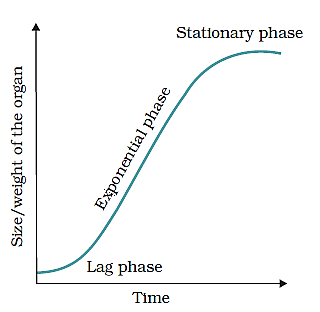
It can be represented by
Wt = W0 ert
W0 is the initial size, it can be increased in the number of cells, weight or height
Wt is the size after time ‘t’
r is the growth per unit time or also referred to as efficiency index
e is the base of the natural log
Most of the living organisms follow the sigmoid curve of growth, e.g. cells, tissue and organs of plants.
Conditions of Growth
Essential elements required for growth are:
- Water is essential and also required for enzymatic activity. Turgidity helps in growth
- Oxygen is required for respiration and metabolism of organic compounds to release energy required for growth
- Macro and micronutrients are required as an energy source and for the synthesis of protoplasm
In addition to these, optimum temperature, salinity, light, etc. environmental factors also affect growth
Differentiation
Meristematic cells differentiate and undergo structural changes to perform specific functions, e.g. tracheary elements develop lignocellulosic cell walls, which is strong, elastic and required for the transport of water to long-distance, peripheral meristematic cells develop into the epidermis and cells present apically differentiate into the root cap.
Dedifferentiation
When living differentiated cells regain their ability to divide and differentiate, the process is called dedifferentiation. E.g. parenchyma cells again differentiate into the cork and interfascicular cambium.
Redifferentiation
The dedifferentiated cells again lose their capacity to divide, it is called redifferentiation.
Development
Development refers to growth as well as differentiation. The development includes all the phases of the lifecycle from seed germination to senescence.
Development is controlled by various intrinsic and extrinsic factors:
Intrinsic Factors: These include genetic as well as hormonal control
Extrinsic Factors: Environmental factors like oxygen, temperature, water, nutrients, etc.
Plants form different types of structures in response to various environmental conditions. This is termed as plasticity.
Heterophylly refers to the different shapes of leaves present at different stages of life or in different environmental conditions. E.g. In coriander, cotton and larkspur, leaves are of different shapes at juvenile and mature stages. In buttercup, the leaves of terrestrial and aquatic habitats are different.
Plant Growth Regulators (PGRs) Characteristics
They are chemical compounds and found naturally in plants. They are also synthesised commercially and used in agricultural practices. They are known as plant hormones or phytohormones.
- They are derivatives of adenine (kinetin), carotenoids (ABA), terpenes (GA3) and indole compounds (auxins). Ethylene is a gaseous hormone
- They are present in a very low concentration and act as chemical signals between cells
- Environmental factors influence gene expression and hormone production
- Plant hormones may show different effects at different stages and at different concentrations
- Plant hormones act by signal transduction, i.e. an external signal is converted to internal signal and which in turn causes one or more cellular responses
- According to their actions, they can be classified into two categories:
- Plant growth promoters, which induce cell division, elongation, differentiation and the formation of flowers, fruits and seeds, e.g. auxins, gibberellins, cytokinins
- Plant growth inhibitors are linked to dormancy, abscission and various stress responses, e.g. Abscisic acid (ABA)
- Ethylene, the gaseous hormone has inhibitory as well as growth-promoting effects
- Brassinosteroids also have been discovered to work as a phytohormone
- Different plant hormones may work antagonistically or complimentary (synergistically) to each other. There are many events that get affected by more than one phytohormones, such as apical dominance, dormancy, abscission, senescence, etc.
Important Discoveries of Phytohormones (PGRs)
- Charles Darwin and his son Francis showed that there was some substance at the tip of coleoptile of canary grass, which is transmittable and responsible for the phototropism, i.e. bending towards the light
- Auxin was first isolated from human urine
- F.W. Went isolated Auxin from the coleoptiles of oat
- E. Kurosawa discovered that foolish seedling or ‘bakanae’ disease of rice seedlings was due to the presence of gibberellic acid in the fungus Gibberella fujikuroi
- Skoog discovered that callus proliferation in the internodal region takes place, only if auxin was supplemented with coconut milk or DNA, yeast or vascular tissue extract
- Miller et al later identified and crystallised cytokinin and termed as kinetin from herring sperm DNA.
- H.H. Cousins discovered the presence of a gaseous substance in ripened oranges, which hastened the ripening of bananas
Physiological Effects of PGRs
Auxins

Produced in root and shoot apices. It gets transported to various parts. The transport of auxin is polar or unidirectional. Natural auxins- IAA (Indole acetic acid) and IBA (Indole butyric acid), synthetic auxins- 2,4-D (2, 4-Dichlorophenoxyacetic acid), NAA (naphthalene acetic acid).
Effects of auxins:
- Apical Dominance
- Induces cell differentiation in xylem
- Induce parthenocarpy, i.e. formation of seedless fruits, e.g. Tomatoes
- Promote flowering, e.g. Pineapples
- Delay abscission of young leaves and fruits, whereas, promote falling of older leaves and fruits
- Root initiation in stem cuttings for vegetative propagation
- 2, 4-D is widely used as herbicides to kill dicot weeds
Gibberellins
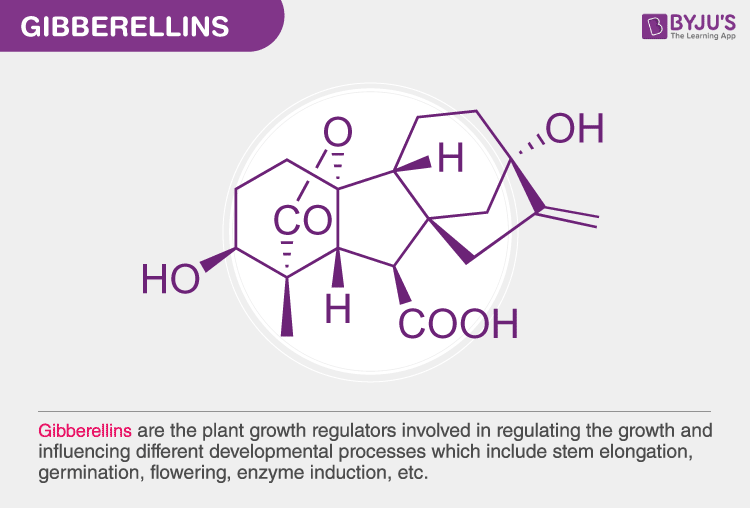
More than 100s gibberellins are found. GA3 (Gibberellic acid) is one of the first and the most common gibberellins. All the gibberellins are acidic.
Effects of gibberellins:
- Cell elongation
- Delay in senescence
- Stimulate malting process
- Internode elongation
- Promote maturation and seed germination
Cytokinins
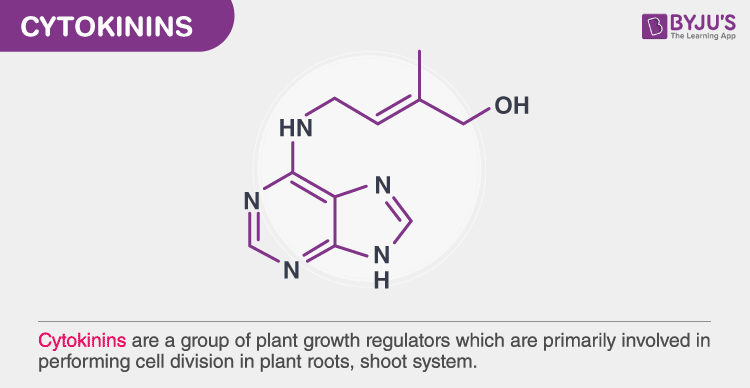
There are many naturally occurring cytokinins, e.g. zeatin. They influence cytokinesis and are produced in the rapidly dividing cells, e.g. growing buds, young fruits and root apices
Effects of cytokinins:
- Cell division
- Inhibition of apical dominance, i.e. promote lateral shoot growth
- Delay of leaf senescence
- Embryo development
- Seed germination
- Promote nutrient metabolism
- Formation of chloroplasts in leaves
- Adventitious shoot formation
Ethylene

It is a gaseous hormone. Produced by ripened fruits and tissues undergoing senescence. Ethephon is the most widely used compound
Effects of Ethylene:
- Fruit ripening, e.g. tomatoes, apples,
- Senescence and abscission of leaves, flowers and fruits, e.g. cotton, walnut, cherry
- Maintenance of apical hook on seedlings
- Breaks seed and bud dormancy and initiates seed germination, e.g. peanut seeds, potato tubers
- Root initiation
- Internode and petiole elongation in water plants
- Promotes flowering and femaleness, e.g. cucumbers, mangoes
Abscisic Acid (ABA)
It is known as the stress hormone. It acts as an inhibitor of plant growth. It is produced in all the cells containing plastids. It is an antagonist of GAs
Effects of ABA:
- Seed dormancy
- Closure of stomata and tolerance to various stresses
- Seed development and maturation
Brassinosteroids
They are produced in seeds, fruits, leaves and flower buds. E.g. brassinolide
Effects of brassinosteroids:
- Light-mediated gene expression
- Cell division and cell elongation
- Seed germination
- Vascular development
To learn in detail about plant hormones click here
PGRs provide intrinsic control but they, along with genetic and extrinsic or environmental factors, influence plant growth and development, e.g. tropic movements (phototropism, geotropism), photoperiodism, vernalisation, seed dormancy and germination, etc.
Photoperiodism
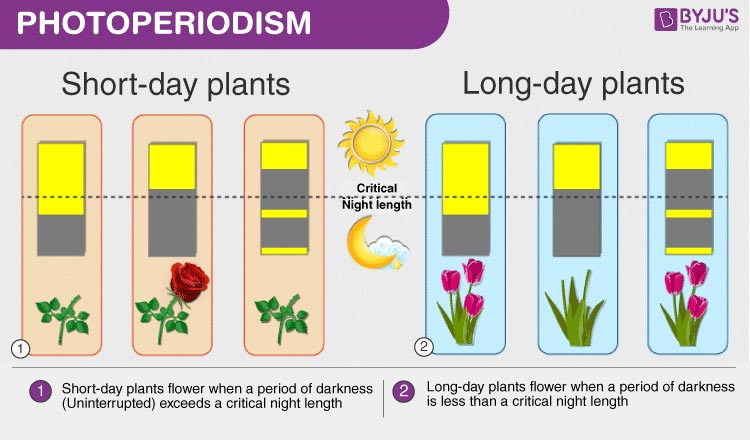
It refers to the effect of the duration of light on plant growth and development, especially flowering. Flowering plants are classified into the following categories, based on their flowering pattern in response to light:
- Short day plants: Flowering is initiated on the exposure of light for a shorter duration
- Long day plants: Flowering is initiated on the exposure of light for a longer duration
- Day-neutral plants: Flowering does not depend on the duration of light exposure
Vernalisation

It is a temperature-dependent phenomenon. Flowering is promoted by a period of cold temperature. Seeds are cooled during germination to accelerate flowering.
- Wheat, rye, barley, etc. food crops are grown twice in a year. Spring varieties are planted in spring and harvested at the end of the growing season. Winter varieties are planted in autumn and harvested in mid-summer. Winter varieties will not flower within the growing season if planted in spring.
- Biennial plants need a period of low temperature to flower in subsequent months, e.g. cabbage, sugarbeet, carrots
Seed Dormancy
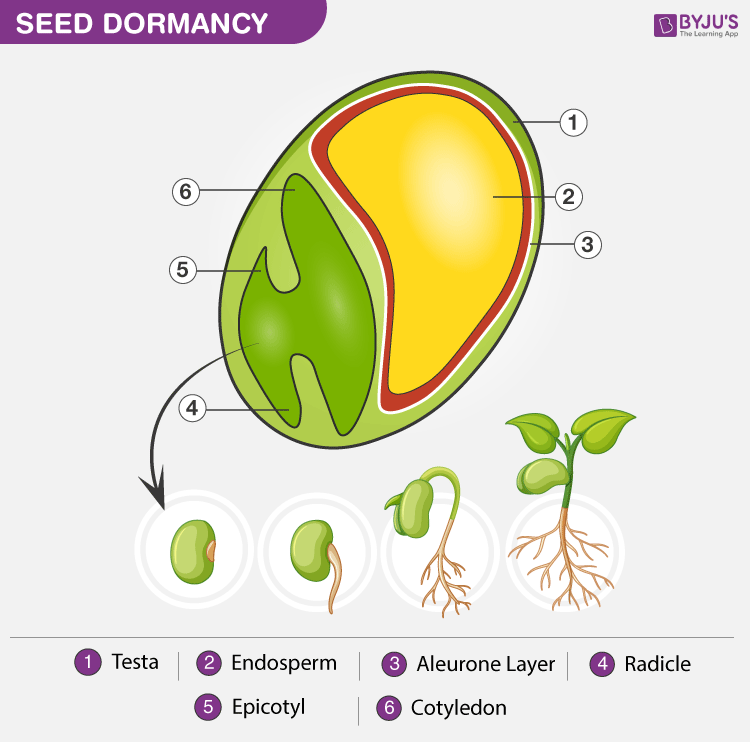
Seed dormancy is controlled endogenously. Seeds do not germinate even in favourable external conditions. Seed dormancy is caused by various factors:
- Hard and impermeable seed coat
- Chemical inhibitors, e.g. ABA, para-ascorbic acids, phenolic acids, etc.
- Immature embryo
The seed coat is broken by natural abrasions such as microbial action and digestive tract enzymes in animals, which eat seeds. This can also be induced artificially by knives, vigorous shaking and sandpaper.
The effect of hormones can be overcome by cold temperatures, nitrates and gibberellic acids.
Explore the next chapter for important points with regards to NEET, only at BYJU’S. Check the NEET Study Material for all the important concepts and related topics.
Also see:
NEET Flashcards: Transport In Plants
NEET Flashcards: Mineral Nutrition
NEET Flashcards: Photosynthesis In Higher Plants
NEET Flashcards: Respiration In Plants
Flashcards Of Biology For NEET Plant Growth And Development
Recommended Videos:


Comments